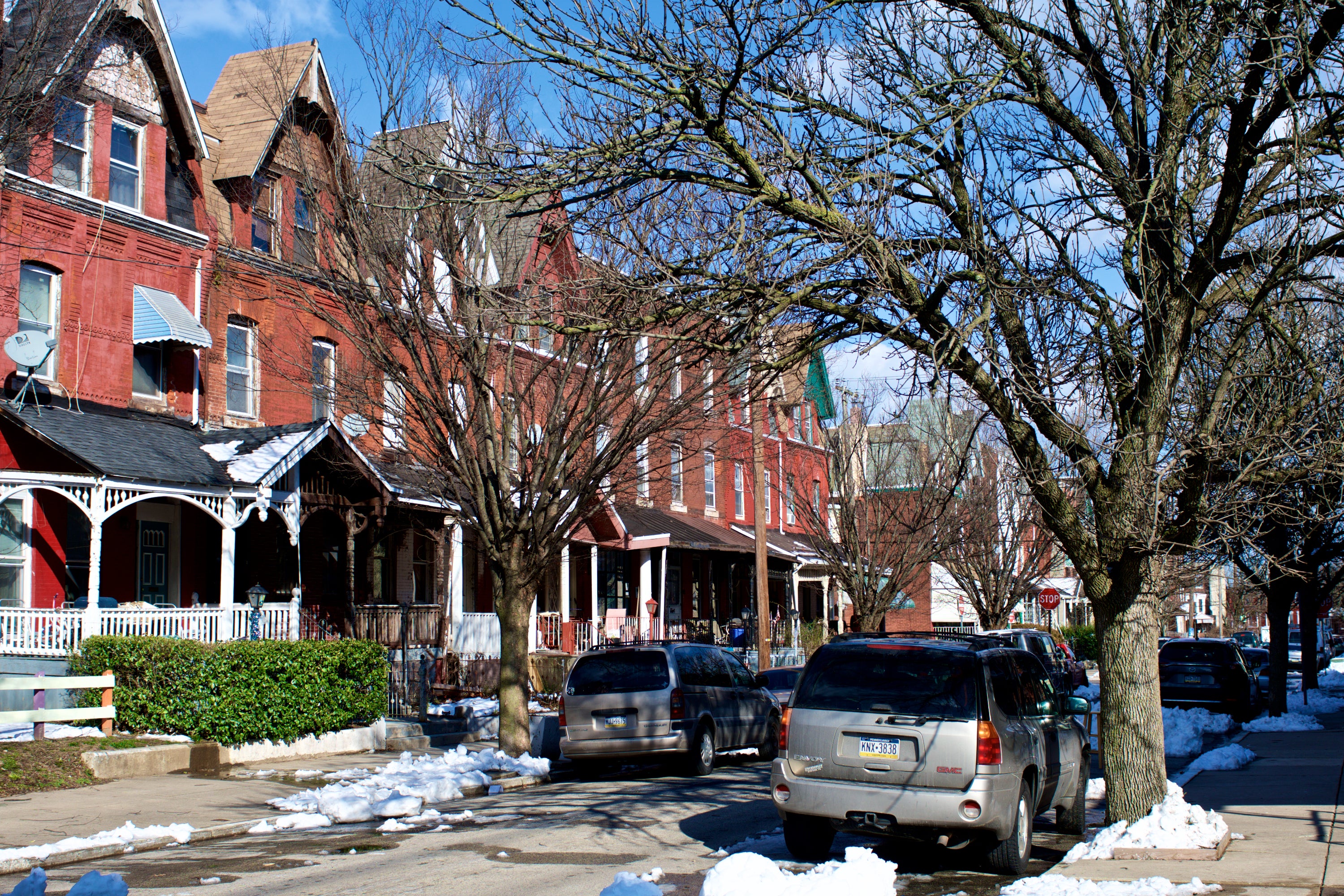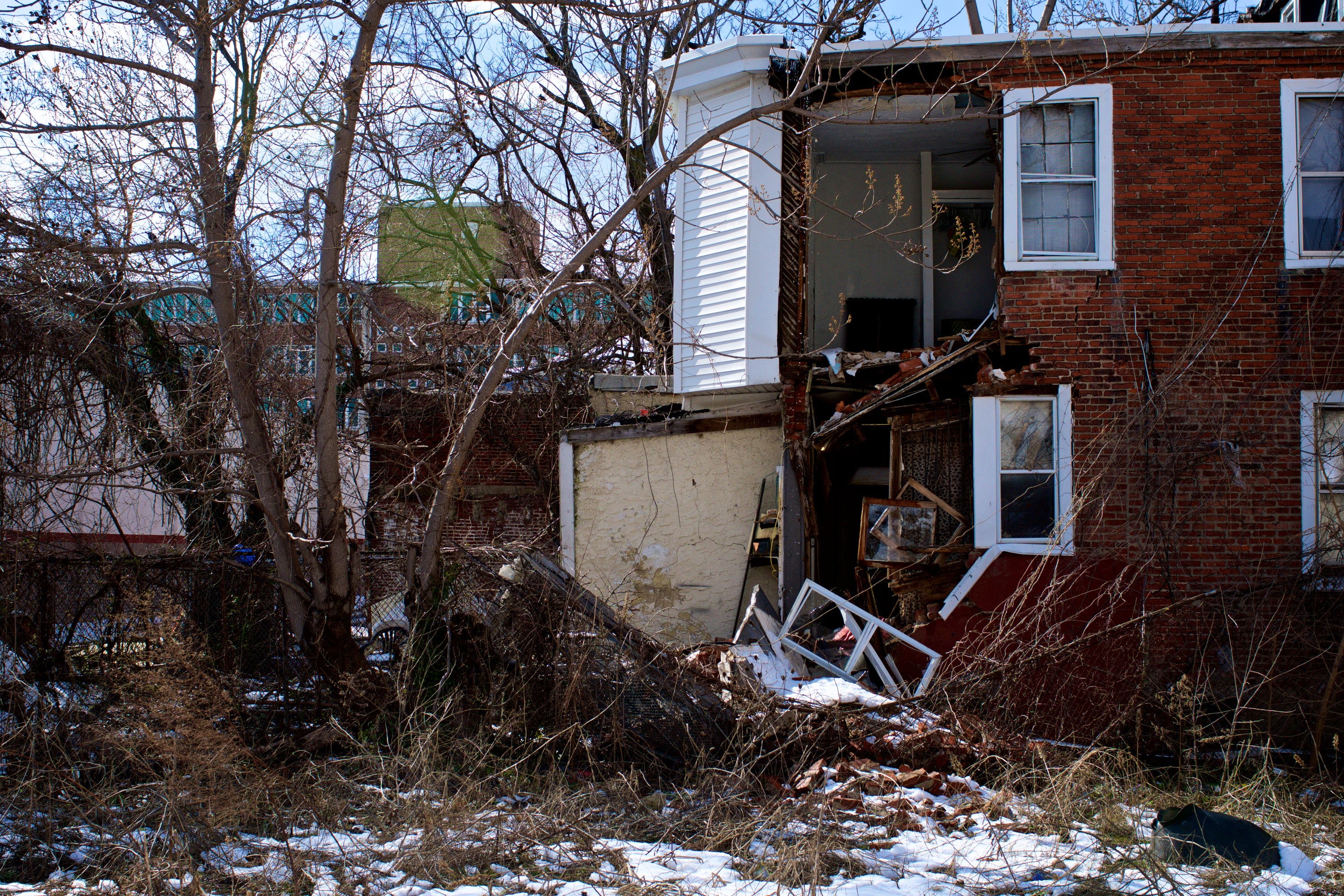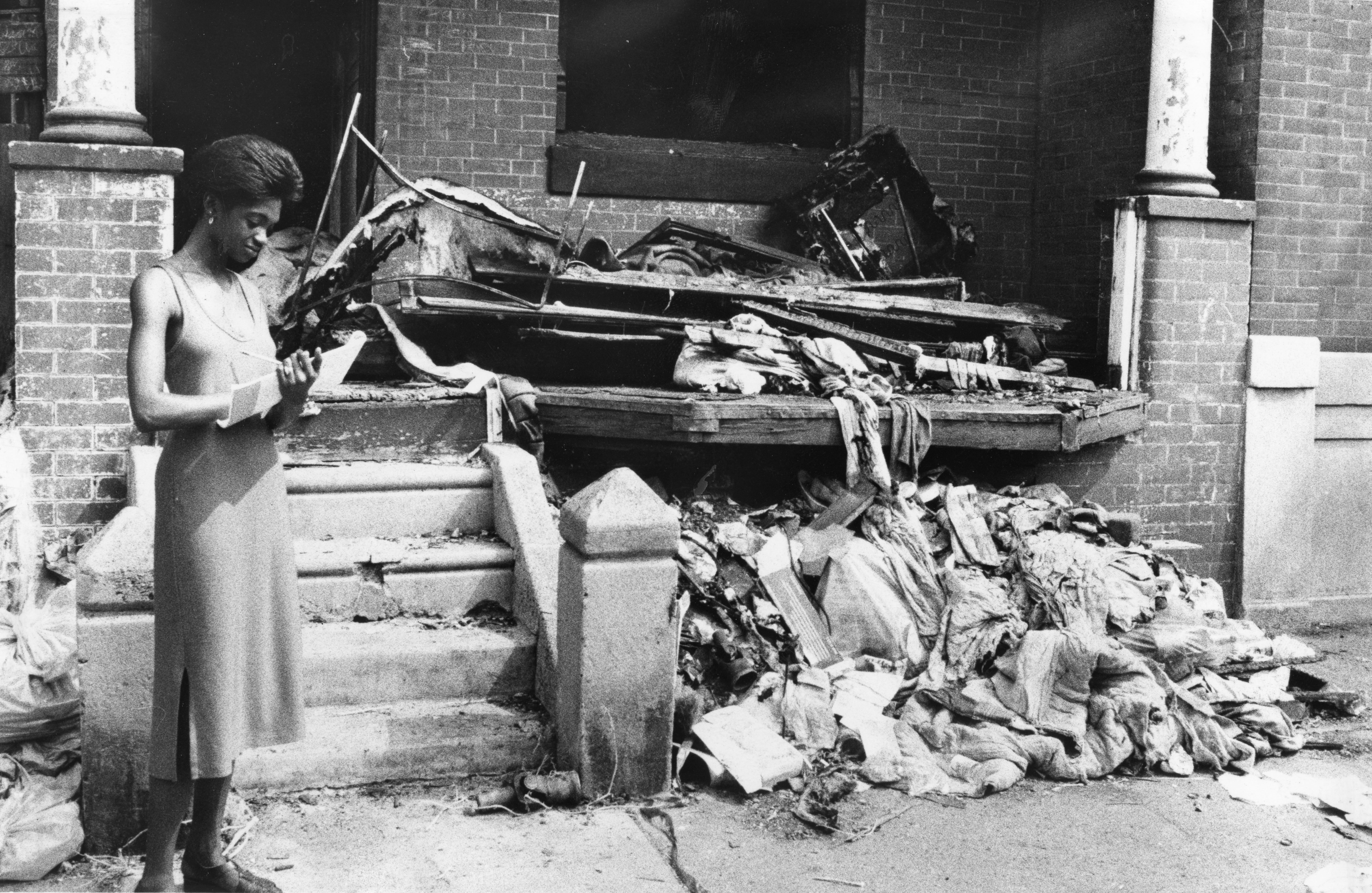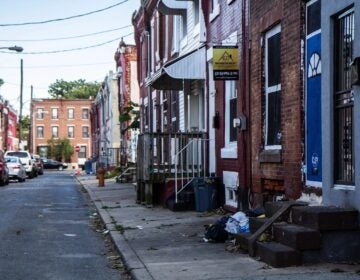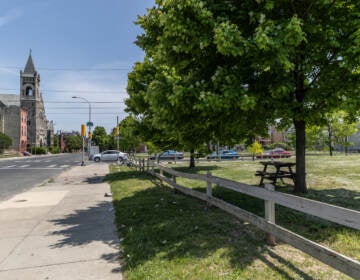‘We want to see growth’ too: Why Tonetta Graham isn’t worried about Philly hipsters moving into her neighborhood

If Strawberry Mansion gentrifies, Tonetta Graham knows her block is bound to change. She owns a house on 30th Street, right around the corner from her childhood home. It cuts a striking figure. Painted candy apple red with white trim, Graham’s house stands alone, the sole remaining building on this side of the block. Vacant lots surround it, some strewn with tires and old mattresses.
“I know development will happen on my block,” Graham, 50, says, with a wry laugh. “In a couple years from now, I see infills going in here.”
But unlike many of her neighbors, Graham, the president of the Strawberry Mansion Community Development Corporation, isn’t worried — and she doesn’t want anyone else to worry either. She sees the silver lining of change to come. Strawberry Mansion has gone through wave after wave of transformation over the past century: redlining, white flight, riots, the crack epidemic. Now the neighborhood seems poised to change in a way that could restore the well-tended, shop-lined streets she remembers from her youth. This time, Graham wants the main beneficiaries to be people like herself, residents who stuck with the neighborhood during its darkest moments.
“I think that’s a misconception: They want it to stay the same,” says Graham. “We want to see growth; we want to see restaurants and eateries, where you can bring your family. We want quality schools as well. We just don’t want to be planned over.”
To say Strawberry Mansion is gentrifying might seem like a stretch. It’s long been one of Philadelphia’s poorest neighborhoods. In 2000, incomes in Strawberry Mansion were among the lowest in the city. But housing prices are shooting up fast nearby. Median home prices in the 19121 zip code, which includes Strawberry Mansion and Brewerytown, rose by 68 percent between 2010 and 2016. That was the third biggest increase of any zip code in the city. After decades of disinvestment and devaluation, predominantly black Strawberry Mansion is looking more and more appealing to developers and the young, upwardly mobile, and increasingly, white.
I know this because I moved to Strawberry Mansion a year ago. I live about 10 blocks from Graham and a block and a half from Fairmount Park. When I don’t feel like cooking, I can take a quick walk to Brewerytown’s rapidly gentrifying stretch of Girard and grab a $5 slice of pizza or sit down for a $20 prix fixe two-course meal. My roommate bought her gorgeous rowhome — three stories, with a backyard, a basement, and a porch — on the cheap and we piled in like the poster-child gentrifiers that we are, with our chickens and her rescued pit bull and quirky porch furniture. We’re the first white people to live on the block since the last Jewish families left in the 1960s.
”This thing in Strawberry Mansion that I grew up with was, “They’re coming. They want the neighborhood back,’” says Graham. “‘They’ was never really defined but that was the term, ‘they’re coming, they’re coming, they’re coming.’”
Starting a few years ago, Graham began to see the tide turning in Brewerytown to the south and East Falls to the north: white people, moving into houses made affordable by decades of policies devaluing communities of color. “It’s amazing because as a kid you hear that — ‘They want it,’ and I used to think, ‘But they already had it,’’ says Graham. “What do you mean, why would they just want it again?”
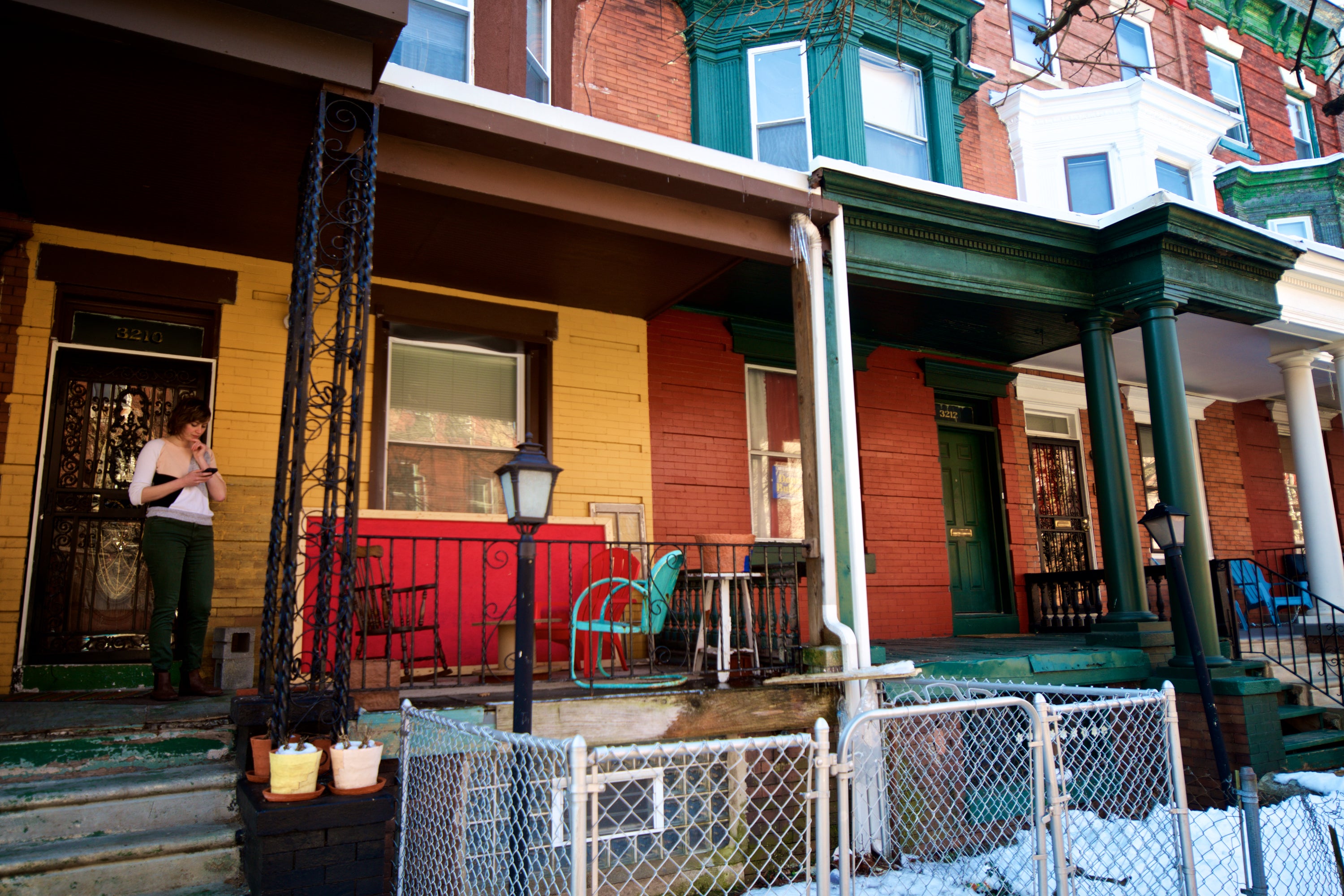
Graham’s childhood self may have been confused, but today she knows exactly what makes Strawberry Mansion so appealing, why the hipsters, as she calls us newcomers, are trickling in. “Folks see the potential in Strawberry Mansion; they see the amenities,” she says. “Fairmount Park is our backyard. We have access to transit; there’s ease in getting just about anywhere.”
Now new schools are proposed for the neighborhood, new housing, new places for kids to play in Fairmount Park. Graham wants to make sure the neighborhood’s black residents can stick around and benefit from the renewed investment. She says Strawberry Mansion has a secret weapon, if they can keep it: high rates of homeownership, between 50 and 59 percent in the northern part of the neighborhood.
“For a neighborhood that’s considered low wealth like Strawberry Mansion, we own our homes,” she says. “They don’t value our houses at much, but we do own them, and that’s our strength.”
From rich to poor
Ironically, Strawberry Mansion’s black residents were able to purchase homes at high rates because of policies that discriminated against them. Up until the 1940s, this was a Jewish neighborhood, nearly all white. Grocery stores, shoe shops and synagogues interspersed the stately brownstones between Fairmount Park and the railroad tracks.
Then, like much of Philadelphia, the neighborhood was redlined. The federal government deemed it too risky to lend in, and banks followed suit, withholding mortgage loans. Housing values plummeted. At the same time, the FHA gave massive loans and subsidies for new suburban developments, on the condition that they exclude black buyers. Many of Strawberry Mansion’s Jewish families left, spurred on by blockbusting realtors who would sell homes to black families, and then use them as props to incite fear in white neighbors.
Around this time, Graham’s grandmother moved to Strawberry Mansion from the South. She found work in the home of a Jewish family. When white flight began, the family sold her their house — cheap. Graham says this was common. She remembers that when the last Jewish woman on the block passed away, she left her house to the black family next door. In the 1940 census, the street was 100 percent white. By the time Graham left for college in the 1980s, all of her neighbors were black. In about 80 years, Strawberry Mansion went from being one of the city’s wealthiest neighborhoods to one of its poorest.
With low incomes and little access to loans, Strawberry Mansion’s new black majority struggled to keep up their houses. By 2000, the city counted 1,845 abandoned properties in the neighborhood, the most of any single area in the city. The sheer amount of abandonment made it a target for Mayor John Street’s Neighborhood Transformation Initiative (NTI), a 2002 plan to demolish derelict properties and assemble large tracts for new housing development. Neighbors staged protests, worried that the large-scale demolitions would lead to their own displacement. NTI fell short of achieving its goals. Often, where buildings were torn down, nothing replaced them.
Today, blocks like Graham’s, where only a house or two stands amid vacancy dot the neighborhood. While residents want to see the blanks filled in, they worry that acquisitions and demolitions won’t stop at vacant buildings. Not far from Strawberry Mansion, in similarly gentrifying sections of Sharswood and Brewerytown, the city has condemned private property to assemble lots for development.
Today, blocks like Graham’s, where only a house or two stands amid vacancy dot the neighborhood. While residents want to see the blanks filled in, they worry that acquisitions and demolitions won’t stop at vacant buildings. Not far from Strawberry Mansion, in similarly gentrifying sections of Sharswood and Brewerytown, the city has condemned private property to assemble lots for development.
“Folks are scared, and I do understand when you think about eminent domain,” she says. “They heard about it in the Sharswood/Brewerytown area. It creates a lot of tension and anxiety. Why are you taking my property and paying a value for it that’s totally not fair in a lot of their eyes?”
Myriad other threats rattle the homeowners who stop by Graham’s office. Many of Strawberry Mansion’s homes have passed down informally within families. When deed-holders die, family members may not know to file the paperwork to transfer ownership. Those tangled titles have a cascading effect; without a deed, people can’t apply for loans or qualify for some of the city’s home improvement programs. Speculators may take notice of the disrepair and make an under-value offer that looks good to an owner who can’t prove their claims. There have even been cases, Graham says, in which developers have applied for deeds in other people’s names.
“People see vulnerability, and if you have a community that’s not educated about their options, about the power they have in being a homeowner, they can succumb to those things,” she says.
“Rediscovery”
Returning home to work in Strawberry Mansion wasn’t part of Graham’s plan when she left the city for Indiana University of Pennsylvania to study human resource management.
“I thought I’d come back and be in the corporate world, but there was other plans,” she says. When she moved back to Philadelphia as a young adult in the early 1990s, she realized her community needed her.
“That’s when I saw the remnants and ramifications of the crack, how it decimated neighborhoods. Our seniors were afraid to open their doors to the young folks. We’ve always had intergenerational relationships in the neighborhood. I saw that threatened,” says Graham. “I just made a decision. I made a decision that I would stay in Philly, and if I wanted to stay in Strawberry Mansion, I was going to help make it better.”
She started teaching at Strawberry Mansion High School, barely a block from her childhood home. Walking to school made her a novelty to students. “You went to college, what are you still doing in the neighborhood?” they’d ask her. “You don’t have to move away to be successful, that was a message I gave a lot of them,” she says.
Today, Graham splits her time between tutoring, academic advising, and the CDC. Her office, on the first floor of a brownstone on Diamond Street, is small and full to the brim — golden shovels from breaking ground ceremonies, new banners emblazoned with the Strawberry Mansion Bridge that crosses the Schuylkill River in Fairmount Park. She wants to install the banners on major corridors in the neighborhood. “We have definitely outgrown our space,” Graham says. “When it comes to larger CDCs, we’re kind of a baby. We’re new in the game.”
She’s still figuring out what success means for the organization. Unlike more established community development groups, Strawberry Mansion isn’t building. Instead it focuses on preservation and helping neighborhood residents navigate housing dilemmas. The group hosts information sessions about property tax abatement programs, sheriff’s sales, and getting help with mortgage foreclosures. Graham keeps lists of local contractors and union trade laborers that she provides to every developer whose project crosses her desk.
But all of this is very new for Graham, who has no formal training in architecture, urban planning or development. The CDC was only founded in 2004, when Brewerytown’s boom awoke Strawberry Mansion to the need for a community-based intermediary to work with residents and developers.
Denise Clark serves on the CDC’s board. Like Graham, she was raised in Strawberry Mansion and remembers when her family could buy everything they needed right in neighborhood shops.
Then in 1964, the riots happened. Clark remembers watching from her front porch as neighbors took to the streets, some smashing and burning stores. Afterwards, they never reopened. Many were ultimately demolished. “All these years it stayed nothing,” says Clark, who lives next door to me in a house her parents bought in 1956. “I wondered why when I was younger, but not when I was older, why they wouldn’t put nothing back in here no more. They was through with North Philly.”
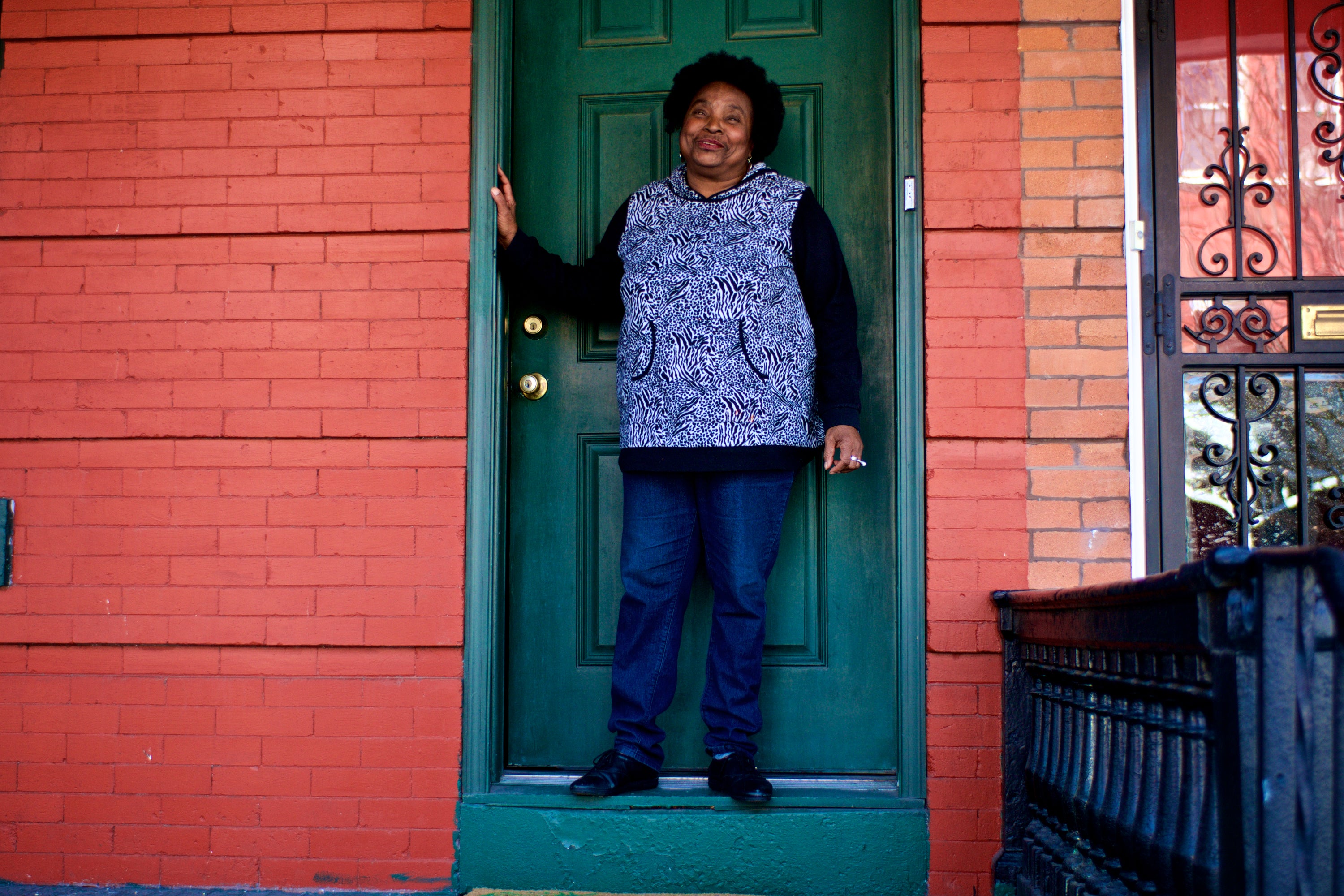
That amenities like banks and supermarkets may now return to Strawberry Mansion feels bittersweet to the 66-year-old. “Banks are going to look at this area now since all these people are moving in, and all the development is going up,” Clark says. “They’re getting a new set of people, people with money.”
One of the first shiny new amenities to land in Strawberry Mansion will be the Discovery Center, a new environmental education center operated by the Pennsylvania chapter of the National Audubon Society and Philadelphia Outward Bound School. The $18 million facility will overlook an old city reservoir in East Fairmount Park. Drained and fenced off in the 1970s, the 37-acre East Park Reservoir had once served as a lush backyard for Strawberry Mansion. The high school track team ran around its perimeter. Graham remembers hiking there as a kid. After the city closed it off, the desolate oasis became a respite for migratory birds. As the neighborhood mourned the loss of their lake, a community of birdwatchers embraced the space and the state’s Audubon branch, based in Montgomery County, began fundraising to reopen the urban sanctuary.
Now the reservoir will be accessible again, but only during the Discovery Center’s open hours, hardly the neighborhood playground it once was. (And, as one bird lover pointed out at a recent public meeting, those hours are in the middle of the day, not the best time to view birds either.) At that same meeting, I heard Graham repeat a line I’ve heard her say so many times I wondered if she was exhausted of it, not just for this project, but the neighborhood as a whole.
“It’s a discovery for you, but a rediscovery for us,” she said, again. Later, I asked, if she got tired of saying it. “No I don’t,” she said, “Because for some reason folks are not hearing.”
They/Y’all/We
It was changes in the park that first told Graham gentrification was coming to Strawberry Mansion. She’d been a self-described tomboy in the park as a kid, catching crayfish in the creek. But when crack swept the neighborhood in the 1980s, prostitution and drug-dealing migrated to the park. Neighbors shied away. By the time Graham taught at the high school, her students hardly went there anymore.
“When people started re-engaging those places again, I was like OK, things are going to happen,” she says.
There were other signs, some literal, like the Berkshire-Hathaway-branded for-sale placards popping up in front of neighborhood houses. Others were subtler, but no less telling, like the proposal for a Goddard School on 33rd Street, a “private preschool and educational daycare center.” To Graham, it looked like supportive services for would-be gentrifiers.
“I was like wow, if people only knew the jewel that is Strawberry Mansion. A lot of young people feel like, ‘I gotta get out of here when I get out of school.’ If you knew how many people want to come in, you’d rethink that,” she says.
When I was assigned this story, the irony didn’t escape me. In fact it struck me as utterly typical of gentrification’s logic: here I am, getting paid to report on a process that’s granted me cheap rent in a neighborhood I really like, while making my neighbors — largely black — worried and vulnerable. My roommate bought this house from a neighbor, Damaris Walker, who moved to the block only nine years ago himself, when he acquired our house for just $25,000. Now he owns five on this block alone. Recently, he tried to purchase a sixth at sheriff’s sale, but lost the bid. The vacant house went for $32,500. “Nine years ago, that house would not have gotten more than $10,000,” Walker says.
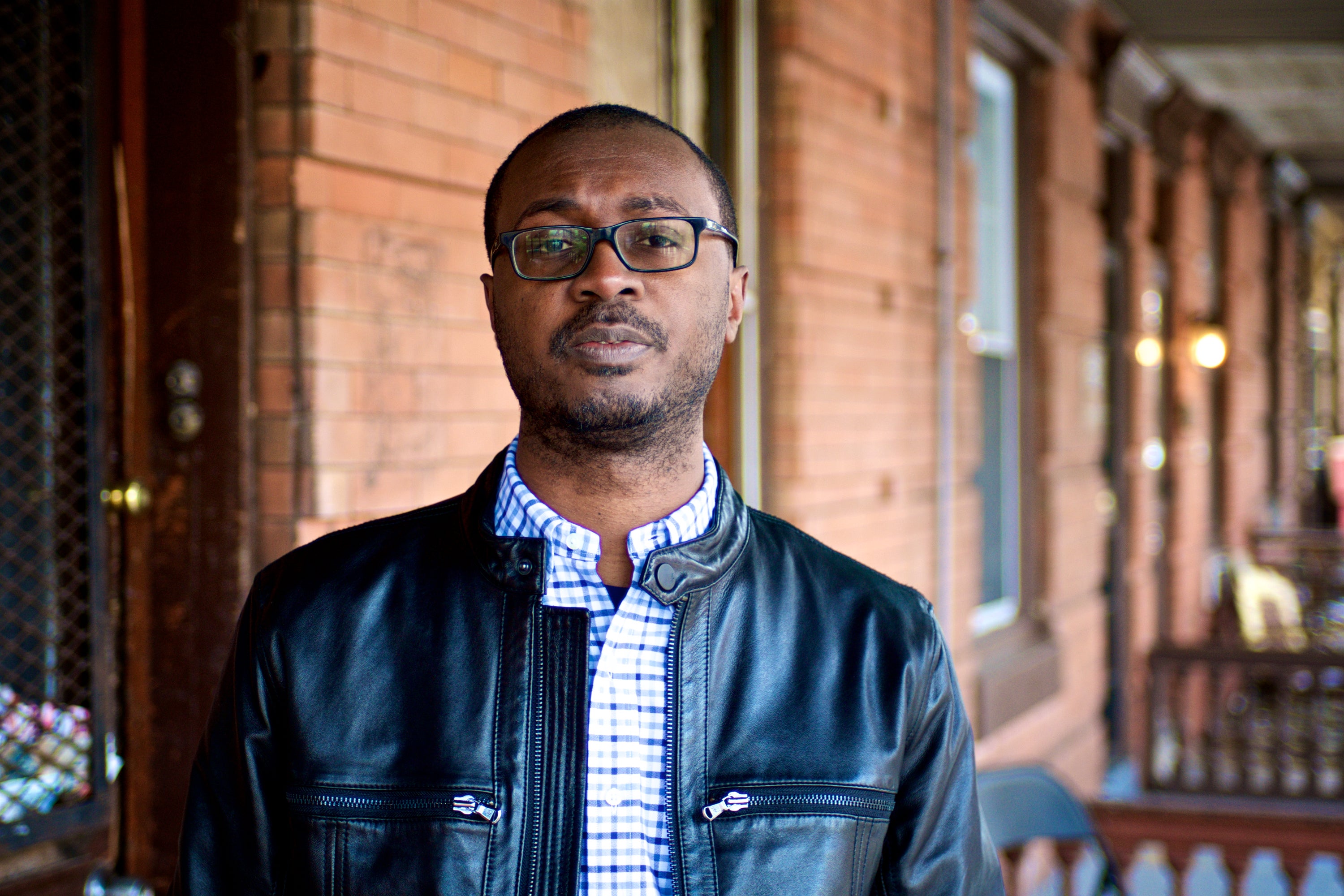
When I talked to Walker about this story, he told me that my roommates and I are, in a way, the blockbusters now — the first white people back on the block in decades, sowing fear. I asked him why, then, he chose to sell to a white woman. Gentrification isn’t just about race, of course — Walker is black, and his purchases have definitely raised eyebrows on the block — but in this neighborhood it’s an obvious harbinger of change.
“I’m in a very precarious situation, because on the one hand I want to keep [the block] exactly the way it is when I found it,” says Walker. “It was quiet, people had been here for 50 years, in some cases you have three generations living in the house. When I bought there was some concern I would upset the character of the block.” One person even asked him to promise he wouldn’t sell to a white person. Walker didn’t.
By the time my roommate purchased the house in 2016, it had been on the market for 197 days. During that time, plenty of people of color looked at the house, says Walker, but many didn’t qualify for mortgages. “And the saddest part to me was that there were people I thought who should give the neighborhood a chance who look like me, who are African-American, and they wrote it off because they thought the price was too high,” he says. “Even though they qualified, they really thought the price was too high for the hood.”
As he expected, Walker’s decision upset some of his neighbors. Clark sucks her teeth and shakes her head when she thinks about the first time she saw my roommate in the yard — less because of my roommate (she says white people returning to the block is “just a sign of the times”) and more because of Walker’s choice. Clark thinks he planned to sell to a white person all along, and that ultimately he’ll sell the rest of his houses to whites too. While we talk, Clark switches back and forth between saying “they” and “y’all” when talking about white people. It’s strange, for both of us, I think, to confront the fact that we are simultaneously individuals and cogs in this huge institutional process. We like each other, I hope. Clark climbs the railing between our porches to hand-deliver flyers about upcoming meetings, and then I drive her to them.
“Because y’all in the neighborhood, and y’all should know what’s going on,” she says, when I ask why. “I would hope that y’all would want to know what’s going on. It seems like the neighborly thing to do.”
Clark’s daughter, though, is deeply wounded by our presence on the block. To her daughter, says Clark, white people moving into Strawberry Mansion is “like a slap in the face.”
Graham recognizes there are many paradoxes of gentrification, in the same way redlining and white flight paradoxically ushered in an era of black homeownership. Then, as now, there was this fleeting moment of uneasy integration. And Graham remembers it fondly. “It was a good relationship, there wasn’t tension,” she says of her childhood block, mostly black, and a little white. “People were neighbors, part of each other’s daily living. Picking up trash, going to the store for each other. I know it’s a cliche and all when you talk about that village, but it was real. The village was alive, the village was healthy, the village was thriving.”
One question now is whether Strawberry Mansion could integrate in a way that’s stable, lasting, and positive for current residents. And there’s another paradox she’s attuned to: that new residents, blind or immune to the dangers and deprivations of the past, might value the neighborhood in ways long-time residents don’t. Graham appreciates the new energy, but really wants young people who’ve grown up here to see the good in Strawberry Mansion too. She has a 14-year-old son, and wants him to think he has a future here.
“I want him to be able to go up the street and see a spoken word artist he saw on YouTube,” she says.
As a CDC, Graham says, “we’re still learning.” So far, the city has subsidized most of the new development in the neighborhood, and affordable housing has been part of the offerings. She’s keeping her eyes out for what’s coming and thinking about how it can best serve the people she works for now: her neighbors.
Sure enough, as we approach her grandmother’s old house, we come across two men Graham’s never met before, standing on the sidewalk with air filters slung around their necks, taking a break from hanging drywall in an identical rowhome.
“’Y’all hooking this up, huh?” Graham calls out, friendly, optimistic. “Looks nice. This is a good block to purchase a house.”
WHYY is your source for fact-based, in-depth journalism and information. As a nonprofit organization, we rely on financial support from readers like you. Please give today.



